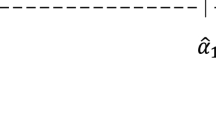Abstract
A study is made of the extent to which correlations between items and between tests are affected by the difficulties of the items involved and by chance success through guessing. The Pearsonian product-moment coefficient does not necessarily give a correct indication of the relation between items or sets of items, since it tends to decrease as the items or tests become less similar in difficulty. It is suggested that the tetrachoric correlation coefficient can properly be used for estimating the correlation between the continua underlying items or sets of items even though they differ in difficulty, and a method for correcting a 2 × 2 table for the effect of chance is proposed.
Similar content being viewed by others
Author information
Authors and Affiliations
Additional information
The opinions expressed in this article are the private ones of the writer and are not to be construed as official or reflecting the views of the Navy Department or the naval service at large. The writer is indebted to Lt. C. L. Vaughn, H (S) USNR, for critical comments on this paper.
Rights and permissions
About this article
Cite this article
Carroll, J.B. The effect of difficulty and chance success on correlations between items or between tests. Psychometrika 10, 1–19 (1945). https://doi.org/10.1007/BF02289789
Issue Date:
DOI: https://doi.org/10.1007/BF02289789




